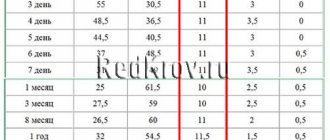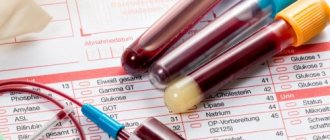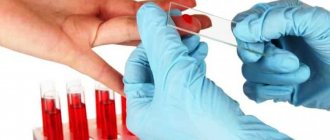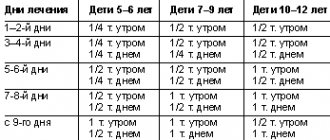Attention!
The information in the article is for reference only and cannot be used for self-diagnosis or self-medication. To decipher the test results, contact a specialist.
A general (clinical) blood test is a common method for studying blood cells and one of the most accessible in clinical practice. When you come to the doctor with complaints about poor health, he will definitely prescribe a blood test. Using it, a general assessment of the patient's health status is quickly carried out. Based on changes in the analysis, doctors draw conclusions about the direction of development of the disease and decide which examination tactics to choose.
What it is
Basophils are a type of leukocyte (white blood cell).
Produced in the bone marrow and present in small quantities in the body. The proportion of basophils from the total number of leukocytes in an adult healthy person is only 0.5-1%. This relatively small presence in the blood is enough for basophils to perform their functions. These include:
- Maintenance of allergic reactions. They migrate to allergic foci, where they release the contents of their granules (histamine, heparin), which ensures the maintenance of the allergic reaction1.
- Protection from foreign agents. Basophils are part of the innate immune system. They are activated upon contact with foreign agents. In particular, this is indicated for parasites.
- Sources of cytokines. Basophils secrete interleukins 3 and 4. In turn, the latter enhance the activity of other immune cells during infectious and inflammatory reactions.
- Improved blood flow. Basophils contain heparin, a blood thinner. During inflammatory processes, this allows immune cells to freely enter the site of inflammation.
Figure 1. Spatial model of the basophil. Image: Blausen.com staff (2014). "Medical gallery of Blausen Medical 2014". WikiJournal of Medicine 1 (2). DOI:10.15347/wjm/2014.010. ISSN 2002-4436 (CC BY 3.0)
Blood test for basophils
Basophils are determined as part of a clinical blood test. In medical documents, the indicator is referred to as “basophils”, “BA%”, “BA” or “BASO”.
Typically, basophils are expressed as a percentage of the total number of remaining white blood cells (BA%). Their absolute number can also be indicated (BA - the number of cells per liter of blood). This is 0.01-0.065x109/l., which is approximately 0.5-1% of the total number of white blood cells.
Cell counting is performed in a special device - a hematology analyzer. This is also done manually. A blood smear is taken, stained with special dyes, after which the basophils are counted under a microscope.
Basophil activation testing is carried out as part of an allergy test. It is possible to find out which allergens the basophils are activated to in order to identify the specific allergen that causes adverse symptoms.
Normal indicators
The blood test form contains two indicators: relative, which shows the proportion of cells in the total number of leukocytes (BA%) and absolute, showing the number of basophils (BA#).
Each laboratory indicates its own normal ranges on the form, since indicators differ among clinics due to the specific equipment used for laboratory tests.
The number of basophils does not depend on gender, age, or time of day. Normally, the relative indicator is: 0-1%, absolute: 0-0.09*109/l. The absolute value gives a more complete picture of health. Sometimes it may be necessary to manually determine cell counts under a microscope.
The interpretation of the tests is carried out by the doctor as a whole, so based on only one indicator it is impossible to establish an accurate diagnosis.
Preparing for analysis
A general blood test requires proper preparation. Before the study, it is important to adhere to the following rules:
- Blood must be donated on an empty stomach. Otherwise, nutrients (entered into the blood) may interfere with the correct determination of the blood formula.
- You should refrain from smoking for several hours before donating blood.
- It is advisable to abstain from alcohol 2-3 days before the planned analysis.
- The day before donating blood, avoid physical and emotional stress.
- The day before you should refrain from taking medications (if possible). If you cannot refuse the medication, you should notify your doctor.
Basophils and estrogens
It has been established that drugs containing estrogen increase the number of basophils. Therefore, if you are taking such drugs, tell your doctor. When deciphering the analysis for basophil content, the specialist will make an adjustment for this.
Basopenia during pregnancy
BAS may be reduced to 0 at the beginning of pregnancy. During this period, the volume of circulating blood in the woman’s body increases, and the percentage of basophilic leukocytes decreases. Absolute BA at the same time is above 0 and most often is within the physiological norm.
During pregnancy, BAS levels are reduced in women suffering from folate deficiency anemia. A high need for vitamin B9 is observed in the growing fetus, the consumption of folic acid for hematopoiesis in the mother and fetus is increased, and the vitamin is also required for the construction of the placenta.
The results of the basophil test for anemia caused by a lack of vitamin B12 were reduced to almost 0%. A diet containing meat, cheese, eggs, and dairy products will help restore the population level to normal values.
Preventive intake of vitamins when planning pregnancy, especially folic acid, can reduce the risk of developing anemia during pregnancy and reduce the likelihood of developmental defects in the fetus.
Agranulocytosis
When the content of granulocytes in the leukocyte formula in adults decreases to a level of 0.75*109/l, a state of agranulocytosis is indicated. The most characteristic sign for it is a sharp decrease in neutrophils, eosinophils and BA levels reduced to 0%.
The absence of leukocytes containing granules, or a decrease in their level to 0%, is noted:
- by blocking the production of these populations in the bone marrow;
- in the case of the formation of immune complexes that destroy their own cells.
The disruption of the formation of granulocytes in the bone marrow is called myelotoxic agranulocytosis, and is provoked in adults by radiation, treatment with cytostatic drugs, antibiotics gentomycin, chloramphenicol, penicillin.
Immune agranulocytosis develops under the influence of:
- inflammatory disease of the thyroid gland, autoimmune thyroiditis;
- infectious diseases - malaria, influenza, polio;
- collagenosis - systemic lupus erythematosus, rheumatism, scleroderma;
- necrotic changes in tissues - ulcerations of the oral mucosa, skin, ulcers in the stomach, intestines.
Agranulocytosis in adults is accompanied by severe clinical symptoms. High temperature, pain in the throat, joints, spasm of the masticatory muscles, difficulty when trying to swallow, severe sweating are manifestations of a decrease in the level of all types of granulocytes in the bloodstream to almost 0.
If the intestines are more affected, then painful bloating and diarrhea are observed. Basophils, neutrophils and eosinophils are reduced to 0 in necrotic ulcers in the intestine; such a decrease in the results of the analysis of granulocyte content in adults indicates the risk of perforation of the intestinal wall.
Norms of basophils in the blood
The normal level of basophils in the blood (BASO) changes in children under 2 years of age.
In adults (men and women), the norm is 0.5-1% (Table 1). Table 1. Norm of basophils (BASO) in the blood by age and gender
| Newborns | Up to 1 month | One year old children | Children under 2 years old | Adults (men, women) | |
| Basophil level (BASO) | 0,75% | 0,5% | 0,6% | 0,7% | 0,5-1% |
Causes of elevated basophils
A high level of basophils is called basophilia. This condition can be dictated by both pathological and physiological reasons. Let's take a closer look at them.
Physiological causes of increased basophils:
- Menstruation and ovulation, when there is a high level of female sex hormones in the blood. As mentioned above, estrogens increase the level of basophils.
- The recovery period after an infection (basophil levels may be elevated for several days or weeks).
- When exposed to small doses of radiation. Often, an increased number of basophils is observed among radiologists or laboratory technicians.
- After taking contraceptives containing estrogen.
Pathological causes of high basophil content:
- allergic reactions²;
- bone marrow diseases³;
- thyroid deficiency (hypothyroidism);
- inflammatory diseases;
- ulcerative colitis;
- autoimmune diseases (eg rheumatoid arthritis4);
- asthma;
- infectious pathologies (viral, bacterial, fungal, parasitic).
Basophilia in children can be caused by other reasons, including:
- poisoning;
- parasites (worms);
- insect bites;
- anemia (iron deficiency, hemolytic);
- allergy;
- nephrotic syndrome;
- sinusitis;
- blood diseases;
- endocrine diseases (usually thyroid diseases);
- gastrointestinal pathologies.
Basophils are counted both manually and under a microscope. Photo: gstockstudio / freepik.com
Causes of low basophils
A decreased level of basophils is called basopenia. This condition is not dangerous to health. It can occur, for example, when basophils migrate from the blood to inflammatory foci. If the basophil has released its granules, then it is already considered inactive. Such cells are not taken into account when counting. For doctors, “empty” basophils serve as an additional diagnostic criterion, which indicates the presence of an inflammatory reaction.
Common causes of a pathological decrease in basophils include:
- Hyperthyroidism is an overactive thyroid gland.
- Urticaria is an allergic disease that manifests itself as a skin rash.
- Lupus is an autoimmune pathology in which foci of inflammation form in the joints, skin, heart and brain.
- Taking corticosteroid drugs. If you are taking such medications, please notify your doctor so that the results can be corrected.
- Depression. The mechanism of the decrease in basophils in depression is unknown, but the fact itself has been established.
- Smoking – contributes to a slight decrease in the level of basophils5. After giving up the bad habit, basophils rise again to normal levels.
Smoking reduces basophil levels. Photo: freepik.com
FAQ
Question: If the absence of basophils in the blood is considered normal, why did the doctor say to retake the test in a week?
Answer: Perhaps the specialist was alerted by other indicators of blood cells, or he suspected a violation of the rules of preparation for the study, the influence of the phase of the cycle, which indicates the risk of receiving unreliable information. A repeat CBC is needed to make sure everything is normal.
Question: How to pass the test correctly so as not to retake it later?
Answer: 3 days before a general blood test, you need to stop taking medications, except for vital ones, and avoid alcohol. During the day you should limit physical activity, stress, and mental stress. The doctor recommends giving up unhealthy, spicy, fatty foods and moderating the amount of protein you consume. You need to eat your last meal 12 hours before handing over the biomaterial. On the way to the laboratory, you need to avoid freezing or overheating; it is better to sit quietly for 10 minutes before visiting the manipulation room. Even if all recommendations are strictly followed, it is impossible to guarantee the absence of deviations. In case of significant violations and suspected diseases, the test will still have to be taken again to exclude an error.
Question: How do periods affect the general blood test? Can I take it during menstruation?
Answer: Hormone levels change significantly throughout a woman's cycle. This affects the activity of the immune system and blood clotting. With bleeding, the concentration of leukocytes, red blood cells, hemoglobin, platelets may decrease, and the ESR may increase. Basophils can either decrease to zero or increase. Often deviations do not go beyond the norm, but this possibility cannot be excluded. Doctors recommend taking an OAC between periods, 3-5 days before or after them.
Question: I took the expanded OAC in two laboratories with an interval of 7 days. First, the test showed the complete absence of basophils, and then the lower limit of normal. How do we understand this and is it worth taking the test again?
Answer: Most likely, medical institutions used equipment of different sensitivity, or minor changes actually took place. A satisfactory result of the second test (provided there are no other abnormalities) indicates complete health. If there are no complaints, there is no need to take the UAC again.
Question: What does an increase in lymphocytes and a decrease in basophil levels indicate?
Answer: The level of lymphocytes increases in many diseases. First of all, you need to suspect acute viral infections, because it is these bodies that recognize viral particles and stimulate the formation of antibodies against them. A decrease in the number of basophils may simply be the result of more active synthesis of other leukocyte cells. If the patient is sick or has recently had an acute respiratory viral infection, there is nothing to worry about. If there are no complaints about your health, you should consult a doctor. This state of affairs may indicate a violation of the immune system.
How to reduce or increase basophils
The physiological causes of basophilia are short-lived and disappear after discontinuation of the factor that increases basophils. Thus, the abolition of hormonal contraceptives and avoidance of radiation bring basophils back to normal in a short time.
As for pathological basophilia, BASO levels can be normalized by starting treatment for the underlying disease. This includes antiallergic therapy, deworming (elimination of worms), treatment of inflammatory diseases and blood diseases.
To reduce the level of basophils in basophilia, it is also recommended to saturate the body with a sufficient amount of vitamin B12 (cyanocobalamin) and iron. These components are found in meat, offal, eggs, fish and dairy products. In some cases, the doctor prescribes preparative vitamin and mineral complexes with iron and B12.
Decreased basophils (basopenia)
With basopenia, the number of basophils is pathologically reduced (less than 0.01*109 /l).
The number of basophils can be reduced in a number of pathologies:
- acute infections and diseases;
- nervous and mental disorders;
- hyperthyroidism (increased secretory activity of the thyroid gland);
- acute pneumonia;
- long-term radiation therapy;
- some cases of acute leukemia.
A decrease in the number of white cells in children can occur due to dysfunction of the endocrine system, lack of iron and vitamin B-12 in the diet.
Only a qualified specialist can decipher the leukocyte form for the number of basophils: a therapist, an infectious disease specialist, a hematologist or a functional diagnostician.










